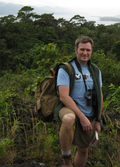
|
Project Summary:

In 2006, Eastern Habitat Joint Venture (EHJV) partners in the Maritime Provinces recognized the need to initiate the development of population habitat models. Starting in 2008, funding was allocated towards achieving this goal and a team (consisting of staff from EHJV partner agencies and Dr. David Lieske and the Geospatial Modelling Lab), was struck to pursue detailed habitat analysis.
The identification of core habitat for maritime breeding Black Ducks (Anas rubripes) was supported by two key data sources: (1) rotary-wing waterfowl surveys conducted by the EHJV and Canadian Wildlife Service, (2) detailed and up-to-date land cover maps for the provinces of New Brunswick and Nova Scotia.
The following paper details the development of the maritime-wide species distribution model (SDM) for breeding Black Ducks, and was the source for the distribution map presented at the top of the page:
D.J. Lieske, B. Pollard, M. Gloutney, R. Milton, K. Connor, R. Dibblee, G. Parsons, D. Howerter. 2012. The Importance of Agricultural Landscapes as Key Nesting Habitats For the American Black Duck in Maritime Canada. Waterbirds 35: 525-534.
Ongoing Work:
- Assessment of a potential net-negative ("break point") effect of agricultural land-use intensity on breeding ducks;
- "The effect of landuse on waterfowl habitat quality in an agricultural region of Atlantic Canada", with the Annapolis Valley as a detailed case study(Masters Thesis: Megan MacIntosh);
Project Partners:
- Black Duck Joint Venture
- Ducks Unlimited Canada
- Canadian Wildlife Service
- New Brunswick Department of Natural Resources
- Nova Scotia Department of Environment, Energy and Foresty
Home
 David J. Lieske is an Associate Professor in the Department of Geography
and Environment, and is the Director of the Mount Allison University
Geospatial Modelling Lab (GML).
David J. Lieske is an Associate Professor in the Department of Geography
and Environment, and is the Director of the Mount Allison University
Geospatial Modelling Lab (GML).